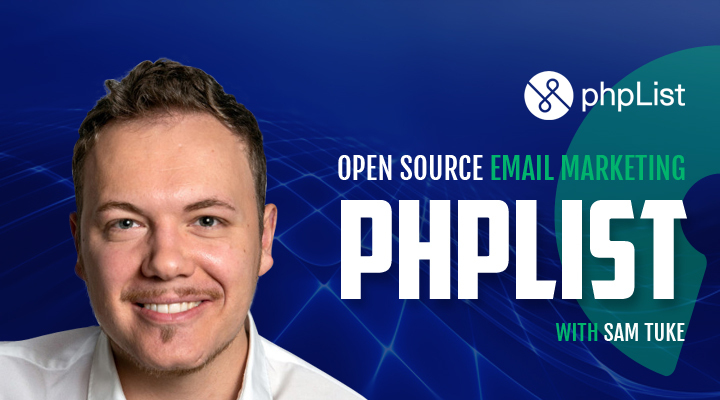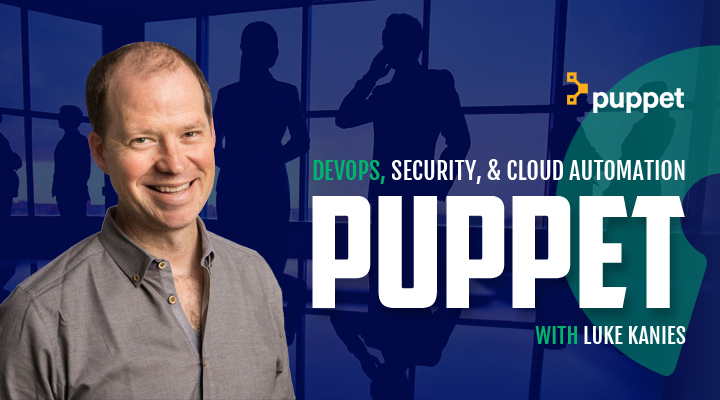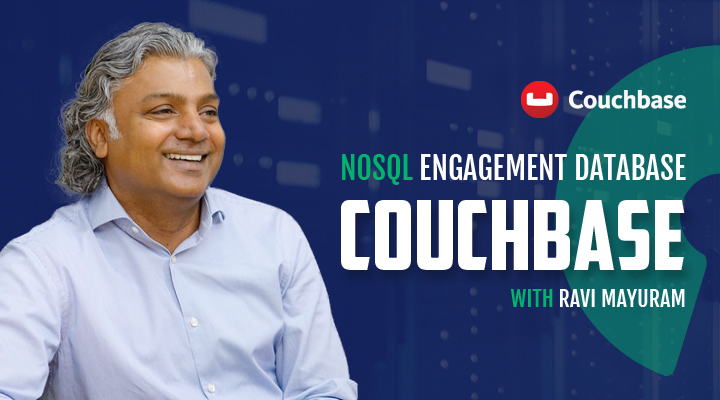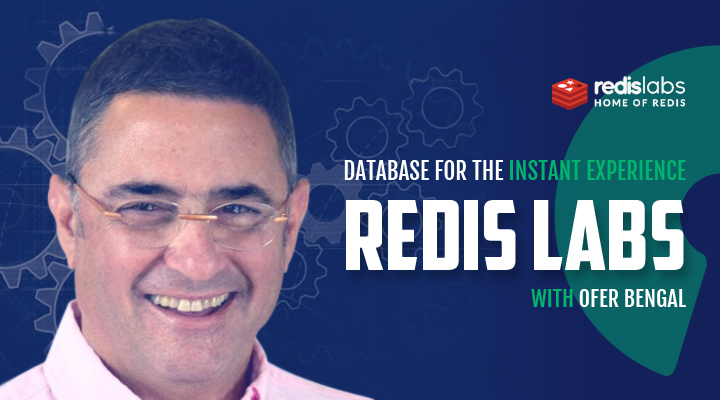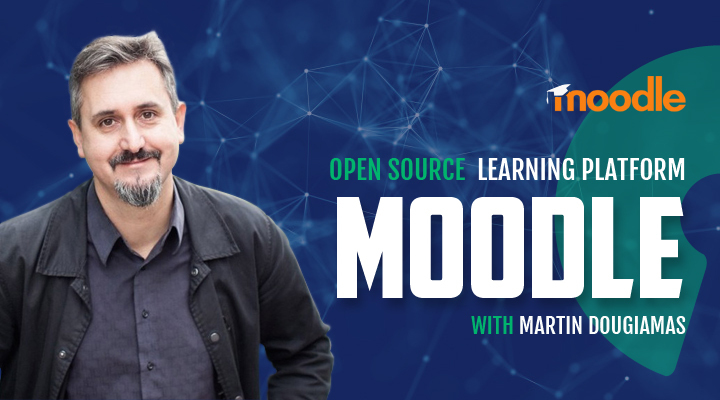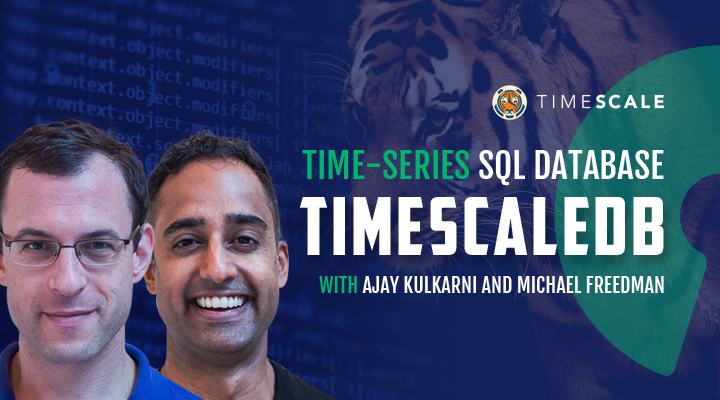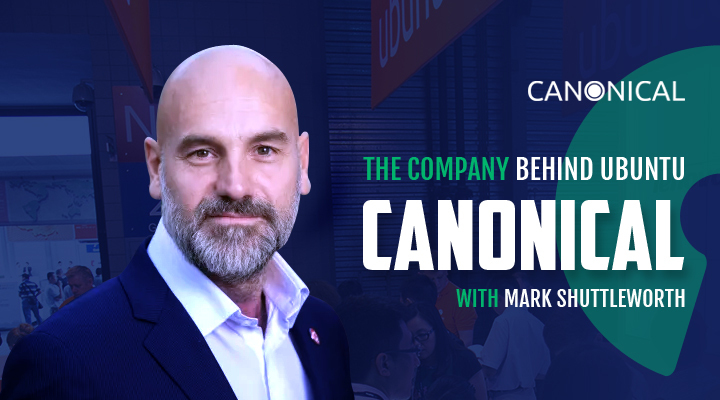Episode 23: pHpList – Open Source Email Marketing with Sam Tuke
Sam Tuke is the CEO of pHpList, an email marketing system powered by open source software. In this episode, Sam discusses the merits of a SaaS business model versus open core.
Transcript
Intro
Michael Schwartz: Howdy, Underdogs. Welcome to episode 23.
Finding all the successful open source software companies is hard work.
You can’t Google it, there’s no master list on Wikipedia, so we read articles, we search the web, and we go to conferences.
In May, I attended a small open source software conference in Tirana, Albania, called OSCAL.
It was a pretty small venue, so I wasn’t expecting to find the next amazing Open Source Underdogs guest.
The morning was progressing as one might expect at an open source conference: Some guy was telling me about a new decentralized messaging protocol; I heard some pretty deep technical content coming out of a government project in Italy.
And then Sam Tuke gave a talk about the role of project managers.
It was pretty obvious that this dude has some serious insights into the business of software development. It sent me digging into his company pHpList. I read some of his old blogs, watched some old videos on YouTube. Sam has had quite the open source journey, so pretty much on the spot, I asked him to be on the podcast.
As I wasn’t expecting to record a podcast on this trip, I was a little unprepared – all I had was my phone, so the audio quality is a little subpar. I think you can understand him, but there’s some weird background sounds I couldn’t filter out – sorry about that.
But I’m glad I had the chance to chat with Sam, and to get some of it on tape. So, let’s cut to it.
OSCAL 2019, downtown Tirana. Here we go!
pHpList Origin
Michael Schwartz: Thank you so much for joining us today.
Sam Tuke: My pleasure.
Michael Schwartz: Tell me a little bit about pHpList, and how you got involved?
Sam Tuke: pHpList is a long-running open source project. It was established as a community project before a company was registered to provide services around it.
Actually, the very first release of the software was nineteen years ago now, so it’s got quite a history.
It came out of a web development agency that was doing consulting with clients, specifically the National Theater in the UK, and nineteen years ago there weren’t so many newsletter solutions available.
pHpList was written and released as open source by the original developer and founder of the project, Michiel Dethmers. Some years later, due to demand, a hosted service was set up and provided. The company was registered, pHpList Limited, it was incorporated in the UK.
For the last ten years, we’ve been offering hosted pHpList services, or as you would describe now email marketing services, like turnkey Software-as-a-Service, email marketing services much like Mailchimp, and Constant Contact, and others that you are familiar in the industry.
We have actually released the first version of pHpList the same year as Mailchimp was founded. So, we have a similar longevity there.
My personal involvement began in 2008 as a user.
So, I’m a long-term open source advocate user. Started out as an open source fan boy, if you’d like. I founded another company when I was 17, called Data Limited, building custom computers, and quickly realized that benefit of open source got more into the political benefits of free software in terms of its relationship to additional rights and empowerment. Taught myself to code as a teenager, and was using pHpList because I was looking for an open source solution for email marketing at the companies I worked at as a marketing manager, later in my career.
Three and a half years ago, in 2015, I’ve been in contact by this time with the company pHpList, and I made some contributions to the software. I was looking for the next opportunity, and I took over management of the company and a lot of stake in the firm.
Since then I’ve been chief executive, responsible for all aspects, both on the community side and the commercial side.
So, the pHpList Community is enabled, supported and sponsored by the pHpList Company.
Challenges of Bootstrapping
Michael Schwartz: So, hosting service normally requires established operating practices and procedures and capital. What are some of the challenges around bootstrapping, and how did you scale the business?
Sam Tuke: Yeah, that’s a good question. We have bootstrapped, we take that approach for a few reasons. Partly to remain independent and stay true to our very strong and relatively inflexible open source approach.
We’ve never accepted outside venture capital investment, so all growth in the business has been from profit, so we continue to just rely on accrued profit basically to reinvest in the firm. And that has meant that we grow up slowly, and we would grow more slowly than some of our competitors would take on capital at a much faster rate.
That brings, obviously, benefits and advantages.
It means we are very stable as a company and as a project, as we’ve been around a long time. We’ve got a small team and a very committed staff, we’ve got pretty low turnover. But we have to be very careful about where we make our marketing investments, and be very smart about it.
We don’t have much margin for error as far as where we put our money. And also, because the company has a technical history, and I have a technical background as well, having been a developer in the past, we are basically more comfortable making big investments in infrastructure, scalability and improving the operations and the service, so it does make for some difficult decisions, how we invest in sales and marketing. We are quite conservative about how we approach that.
We also tend to prioritize technical marketing solutions over interpersonal ones. So the primary driver of growth in pHpList as a company has been this firewall marketing engine, where by our open source users and also most of our hosted-service users, they send their email campaigns, their transactional mail, etc., which includes a little advert for our hosted service at the bottom of every message.
Recently, 25 billion messages were sent using pHpList, a combination of hosted and self-hosted, in one year. And the vast majority of those messages included these little links, which gives us a lot of traffic, promoting our hosted service.
So, that’s the primary engine of growth. As a strategy, we certainly prioritize those kind of “setup once and run.” So, the better, from our perspective, return on investment, and that’s also where our expertise tends to lie in creating these technical solutions, which scale quite well and run themselves.
We have self-service plans, of course. The majority of our customers are the hosted-service, are self- service, as is the case for many Software-as-a-Service platforms. But we also have larger accounts that scale up to around 30 million messages per server.
For those, obviously, the clients tend to have more requirements and require more of our one-to-one consultative sales process. Yeah, we do have a sales team that handles those clients and manages the accounts once they’re established.
Customer Segments
Michael Schwartz: Can you maybe go a little bit into detail who are the customers, and do they break into any segments, or buckets, or types, or do you see any common themes among the customers?
Sam Tuke: There are certainly a lot of common themes. There’s also a huge amount of diversity.
It’s partly having been around a long time, and having been relying on this sort of viral or word of mouth type approach, where you send your campaigns and then people see the links to our service and hear about us frequently in that way. It’s very diverse.
We have quite a few email marketing agencies or more digital marketing agencies, which use our services and resell them.
We don’t offer white-label solutions, but there are various options for companies which want to manage their own clients and provide services through pHpList that way.
And that works quite well. We have a single contact that way, we have a shared interest with those clients, in them using the service well and sustainably.
Beyond that, we have mostly SME’s, as a sort of core customer base, especially for the smaller plans. Primarily in the United States, but we have strongholds of users in a particular regions, so Latin America, Brazil, and Argentina in particular.
pHpList has been translated into over twenty languages for many years, so the localization effort is very helpful for us. We have localization sprints – so we sponsor events to improve the amount of translations that we have in a region, which is interesting or potentially lucrative for us.
But just on the community side, we have translations contributed from really all over the place. We’ve got three varieties of Spanish with 100% translation for the pHpList interface. So, we are really widely spread in that sense, and there’s a great variety of users.
There’s quite a few government users as well. So particularly, government bodies for which data usage sovereignty is very important.
Sometimes they want to self-host the solution on their own service, in which case we provide some consultation, and there’s an opportunity for us to provide services there. Recently, we had two German Federal Ministries sponsoring development of particular functionality for pHpList. It was at the end of last year.
We love to work that way, it’s great. It provides benefits obviously for open source communities,
as other open source companies will be familiar with.
But, there’s a limit to how much consulting I want to do because it’s also quite risky from my perspective. The margins can be lower because of those risks, and obviously, it doesn’t scale in the same way as our Software-as-a-Service business does. So, we have somewhat of a mix there.
And then we have some government bodies who use our hosted service, and we provide them with the flexibility to choose which country their data is hosted in.
We use a variety of hosting providers, and we have a lot of flexibility in the way we’ve organized our infrastructure, so that we can set up all the infrastructure for a hosted client, in a variety of different legal jurisdictions, depending on their requirements. We invested some time and money over the years in making that a very smooth process.
So, certainly those organizations that care a lot about privacy and their sovereignty, that’s a good niche for us.
Partnerships
Michael Schwartz: Are there any partnerships that have helped you develop the business?
Sam Tuke: On the open source side, there are a lot of hosting companies who package pHpList and distribute it for us, and make it very easy to take a lot of the work away from us in packaging, distributing, and really reaching different audiences.
So, every time we have a pHpList release, there are usually four or five different packaging systems that update within a few hours, and announce that they have made releases of pHpList, which helps to get into the hands of our users quickly, and advertise it basically within those hosting systems like Softaculous, for example. We are the only open source email marketing solution that is generally available through those channels.
So, I consider those organizations partners because they are helping to spread the word about our software and making it easy for people to use it and then set it up. Again, that’s been a direct benefit to us because that fits into our viral marketing engine, whereby every self-hosted user ends up advertising our service through the messages that they send.
Beyond that, we clearly have strong partnerships in the open source community. That’s more to do with associating our brand with quality.
Let’s say, when we have users like Raspberry Pi or Wikimedia, particularly in German organizations which care a lot about their sovereignty and privacy, like some larger music festivals, and a few celebrities – they help associate pHpList with their quality content.
We’re always looking for really high-quality senders, people who have a very high engagement rate. And it’s interesting, because open source users and the open source community tend to be very intolerant of low-relevance marketing communications – which is good for us – as much as when we have these projects using pHpList on a large scale for their own communications, they help associate our brand with quality, basically.
And if they are using our hosted service, then it’s great for us because our most desirable kind of clients are obviously the ones with the highest customer engagement, the highest open rates, of the highest conversion rates from their email. Those are exactly the kind of users that we want, and it’s easy to find them, when we look at the open source scene.
By this point, there are some quite large organizations open source, in terms of NGOs, and also commercial organizations, which send mass email communications, and relying on transactional marketing email to communicate with those community. And pHpList is a natural choice for them, and we’re very happy to be associated with them.
Open Source Benefits
Michael Schwartz: How has open sourcing pHpList software been beneficial to the business?
Sam Tuke: When pHpList was first released, it was the only solution for open source email marketing, and it remains to this day the leading solution.
There have been a few other open source projects that have propped up over the intervening years, but we got a huge boost initially as being basically first to market, as the only open source solution available for email marketing and newsletters. So, that provided quite some boost in the early years.
Going forward, like any open source project, we’ve benefited from the expertise of the open source community over time. We have some community members who have contributed plugins, a couple of contributors who have contributed enormously over the last ten years – one individual has extended the functionality of the application in so many ways.
We invested deliberately in a very flexible plugin architecture to allow community members to create their own extensions to pHpList, and also given the freedom to license those extensions differently, and distribute and maintain them how they want.
And for our hosted service, that’s being great in the long-term because we ended up using several of those plugins as part of our hosted service, and it’s seamless.
So, customers of our hosted service don’t know whether the functionality that they’re using originates from company developers or from community developers. But, for example, the segmentation engine that pHpList Hosted uses, which is really called a set of functionality and is quite sophisticated. That is actually our plugin, which is still independently maintained by community members, which is brilliant from our perspective.
Also, the campaign that we have for pHpList Hosted is still maintained by community contributor. So, we’ve got enormous value there.
Of course, it’s a great opportunity for hiring talent.
People who start out as contributors, and we can see the expertise they have, all the commitment they have, we hire them. We’ve done that many times over. It’s kind of a great screening process for getting talent on board, wherever they may be situated in the world.
But beyond that, the primary advantages is the firing marketing engine, which is that we have tens of thousands of open source pHpList servers out there, which are advertising our product in numerous ways, and reporting small amounts of data to us directly. But they’re also referring us a lot of traffic, which gives us a good indication of where these people are – where the largest users of pHpList self-hosted are in the world, which also acts as a good pointer for us as the company to look at, where to expand next, where to improve our localization, where to invest more in support, and a different payment gateways, and really demonstrates a demand.
The use of email worldwide is still growing. Email marketing as a marketing system is still returning best value versus other forms of digital marketing, according to reports by various consulting companies. There’s a lot of potential to grow still, even though we’re in an intensely competitive business, with over 150 different competitors that I am currently aware of, internally.
So, there’s still opportunity for growth, and we still have the unique opportunity as an open source product that gets distributed, gets set up, and starts advertising our hosted service using this viral engine before we are even aware of some of these jurisdictions, or that we’re aware that email marketing is growing in those regions.
So that is tremendously useful for us, and certainly a competitive advantage.
Open Core
Michael Schwartz: In the past, you’ve taken sort of a hard line on the open core business model. I’m wondering if your thinking has evolved over the last couple of years?
Sam Tuke: My thinking has certainly evolved.
Nevertheless, I developed my technical skills and I became a software engineer. I became later a marketer, and I became the CEO that I am now – all because of my belief in open source and its power to harness cooperation, to foster cooperation between human beings.
And still, I’m not a fan of open core. I would not want to take open core as an approach myself.
I appreciate that open core is a very good business model for many companies out there today, and it’s been proven to be successful at a large-scale in recent years. But personally, I don’t want to compromise on the licensing of the code.
I fear the slippery slope that we’ve seen some organizations follow once they’ve taken the open core approach, not all by any means, but it can be very tempting I think, once you take the open core approach to introduce that conflict between the interests of different community members and the company’s commercial goals. And I would never want to be in a position where I felt that there was any strategy that I needed to conceal, or any conflict, in terms of the core userbase and the commercial decisions that we as a company would need to take.
I think that trust in our community is paramount, and I think that’s true of all healthy open source communities, and I think it’s difficult to foster that trust if you have a two-tier system, with different parts of the application, different aspects of its functionality, basically being exclusive to different groups of people. So I still take the hard-line on open core myself.
And when I look at ways to innovate or change our business model, I’m always looking for ways to do that while staying totally aligned with the open source license that we’ve adopted, which is the strongest one that we can find. We use the AGPL3 license for all the code that we produce, and find smart ways to avoid any conflicts that is keeping software open. That’s difficult.
It requires a lot of innovation but I think if you get those models right, and if you get that strategy right, then you have really a sustainable competitive advantage, which is a rarity in the business world.
AGPL
Michael Schwartz: You mentioned that you are using the AGPL, and that license is what I would consider a license that creates user freedom more than developer freedom.
What do you think is the right approach for companies in balancing user freedom and developer freedom in the license?
Sam Tuke: Yeah – it’s a very interesting way to describe the difference between the licenses.
There are a variety of ways to capture the differences. Some people also refer to the non-GPL, like the MIT and BSD-style licenses, which you described as being more pro-developer freedom.
Some people describe them as being more permissive, because they have less constraints on what you can do. I don’t see them that way, and I never did.
I see the recursive of the copyleft, of the viral licenses, the AGPLs and the GPLs, as preserving more freedom overall, both for developers and for users.
Ultimately, it’s about getting more software into the world, which is freely usable and freely reusable.
It’s not so much developers that get the freedom from my perspective, when you are using a simpler or shorter, a non-recursive license, a non-copyleft license – but it’s managers and it’s business leaders who get the freedom.
Because developers, they are usually paid to write code, and they usually want people to use their code.
I mean, my experience, they are frequently happy the more that other developers can see and use what they’ve made, and from my perspective, the best way to achieve that is to ensure that code remains free.
And if you don’t have the copyleft freedoms built into the licensing of that code, then that’s not guaranteed. And there is a good chance that the software they’ve written, and extensions that are added to that software in the future by other people and companies, will not remain free.
And that is the original purpose of the GPL.
That was Richard Stallman’s idea behind writing it with his legal friends in the eighties. And I think that is still a good motivation, and we certainly still stick to the AGPL.
Going forward, I expect to continue to use AGPL license, or at least other copyleft licenses for future projects that I’d be involved with. Of course, once investors are involved, and once you need cooperation from other stakeholders, you don’t always have the freedom to take that, perhaps, more idealistic approach.
But my personal preference is strong copyleft and AGPL3.
Ethics of Open Source
Michael Schwartz: So, I read that you were a philosophy major, or you studied philosophy at university.
So I’m going to ask you somewhat philosophical question: Why is open source software more ethical than commercial software? Are those orthogonal ethics in license?
Sam Tuke: Ethics is a very complex concept, and I wouldn’t want to say that non-copyleft software is unethical, necessarily. However they are certainly in relationship there.
Again, for me, it comes down to a simple concept of corporation, really. And I’m frustrated when I see human beings working against each other when they don’t need to be. And duplicating effort. And basically not working together when they could be, to produce the best product, the best solution, and the best system – the safest systems that they can.
For me, copyleft licensing and open source, it’s really about providing a very safe harbor, a very strong framework to protect that safe harbor for cooperation. For guaranteeing the rights of people who come later to participate in that cooperation, to take the software that was made and to use it themselves for whatever purpose that they want.
My father was a doctor, he is in the medical profession. He worked for the National Health Service in the UK for 60 years, as a public servant in public health. And I feel I inherited some medical perspective on this in that, ultimately, we want to produce the best things that we can, and we want to do the best that we can for patients, if we are in the medical profession. We want to do the best we can for users, again providing the most efficient, the most powerful, the most innovative services that we can, and products that we can.
Now, this becomes a big problem when we try to monetize open source, because what we end up with, with open source software, is software which provides enormous value to the user and to the customer; economic value – value that you can measure. But it’s very difficult to capture that value as a business, or as the organization which is producing that software, in many cases.
I’ve spent a lot of time thinking about how we can do a good job of capturing the value that we create in open source. Because if we don’t, then we starve ourselves the resources that we need to improve our software for others to distribute it to market and to advertise it.
Maybe the Linux desktop is an example of this. Which, I use Fedora on my Linux desktop, and many people use Ubuntu on their Linux desktop – I think it’s a great product. Single-digit percentage of computer users use it, even though for many, it would be a great solution. And that’s partially because I think Linux desktop as a whole, and the developers that make it, have a really hard time capturing the value that it provides.
So, how can we devise value appropriation regimes as open source businesses and business leaders that allow us to scale and compete?
Because we need to put this money into marketing, into these competitive places, in order to get the exposure and compete on a level playing field. But when we’re giving what we produce away for free, it’s hard to capture that value.
There are ways to do it, and they are harder than the other road, but I think it’s absolutely worth it, and from my perspective, it is necessary to find a way to achieve both. To provide the best value for our society, the most freedom for our users, and also to do it in a sustainable way, from the commercial side, and to pay our developers well, and scale the company in a competitive way.
pHpList in Five Years?
Michael Schwartz: Where do you see pHpList in five years?
Sam Tuke: Large-scale email communication should be something that is as easy to drop into your application as single sign-on or a marketing page.
And as an open source application, pHpList is becoming more portable and is more easy to integrate, and we want it to be the no-brainer solution for people who want to add those capabilities to their application, whether it be on a self-hosted bases or using our hosted services.
So, in five years, pHpList will be the most convenient, the lowest friction, and certainly the best value way to communicate transactional or marketing messages with your audience, whoever they may be and wherever they may be.
And you’ll have more choices as far as where that system is running, on which server it’s running, and exactly the details and the nature of how it runs, and how it serves your needs than any other solution.
Business Challenges of Open Source
Michael Schwartz: What do you think are the biggest challenges facing companies, especially startups today, who want to use open source software development to develop their product?
Sam Tuke: You mean, who want to make open source products themselves?
Michael Schwartz: Yes, vendors, let’s say pure-play open source companies who want to actually monetize the open source software that they’re developing in some way.
Sam Tuke: It’s hard to appropriate the value. It’s relatively easy to create enormous value for your users, for society even, through new open source products – the difficulty is capturing the value. And that’s really hard.
Again, what we typically see is high economic value from the most successful open source products and low willingness to pay from the target market from their audience. And that is the kernel of the issue that open source startup will face.
It’s getting easier from my perception to achieve venture capital investment in open source startups, partly because the talent requires the expertise – it’s increasingly part of the strategic advantage of one organization versus another. It’s also a good reason to acquire an open source company.
And somehow that does provide a barrier to new market entrants, that you’ve got great efficient systems set up, you’ve got your teams set up, and so on. But still, how to appropriate value in a way which is compatible with all this value that you’re giving away is really hard.
One way to do that is through data. We’ve seen that data companies wanted a better term, like companies for which data is the real product, which creates services around the data, which empowers them to provide services to consumers for free. They’ve done phenomenally well, they’ve scaled incredibly, and they’ve inspired a generation of entrepreneurs to follow in their footsteps, basically.
Open source products are in quite a good position to compete on that level, because when you have a good open source product; you have a wide-scale adoption; it’s hard to compete with free, we still have big advantages in terms of distribution, in terms of buy-in from technical decision makers.
If you’re first to market, and you’re open source – then you really knocked the bottom of the market out for competitors that want to follow. It’s pretty hard to follow a successful open source app which has become the de facto standard. We can look at a lot of examples of open source products over history that have done exactly that.
But once you’re in that position of having very strong market position with your open source product, you are in a great place to collect data ethically, collect data and use that data to fuel your growth as your primary revenue source.
Because that doesn’t require you to charge for the product. It doesn’t require you to put up barriers around functionality, or paywalls around particular levels of the service for the product. You’re fully aligned with your users in that you want the product to be as good as it can be so that it has maximum adoption that it can have.
And the more adoption your product has, the more data will be flowing to you, ethically again of course, with the understanding of the users of your product. But that really gives you a great advantage because why would users want to turn to a proprietary competitor with less likeability, less freedom and that is less established.
Once you’ve achieved that lead, once you’re there in that position, I think you’re in a very strong position once you’re there. And increasingly, data will be a great business model for these open source companies to avoid conflicts with the interest of their users.
Advice For Entrepreneurs
Michael Schwartz: So, the goal of this podcast is to help entrepreneurs, the people more than the companies. So, as a final question, I’m wondering if you have any advice for those entrepreneurs. When you were just getting started – what was the advice that you wish you had heard maybe a couple years earlier?
Sam Tuke: That’s a great question. I love that question.
Again, this is not necessarily specific to open source, but I once read that entrepreneurs don’t choose the right ventures, the right ventures choose them – I think that’s very true.
I think you need to keep throwing against the wall until you find something that sticks.
I think you need to have the courage to pivot over and over again until you find something that feels right and is sustainable.
I think wearing your core values on your sleeve is something I wish I had done earlier on. Because, as I mentioned, I’ve always been personally committed to open source, and I don’t talk about it nearly enough.
It’s proven to be a great motivator for staff in our company. It’s become something explicit over time in the companies I’ve worked in, and I could have been more explicit about that right from the start.
So when you know very clearly what your personal values are associated with open source software, I think it gives you an advantage to shout that from the rooftop, make it really clear, and don’t be shy about inspiring your workforce with those values, too.
It’s something that’s specific to what we do in the world of open source software, and it’s an advantage all of its own.
Enjoyment is critical. Enjoyment is a really important part of making successful products.
If you as a manager aren’t enjoying what you’re doing, if you haven’t been able to solve the enjoyment aspects of some of the work that you’re doing. For example, I’ve spent a lot of late nights on sales calls, which made me kind of miserable, speaking to Americans in California time zone. It can be quite isolating early on when you’re trying to get those first week sales, and you’re not sure what the person on the other end of the phone wants to hear.
That can spread, it becomes clear, it’s good to ask for support from your staff, to trust your senior staff, and to recognize that your own enjoyment of the work that you’re doing is very important, not only to you, but to all the people affected by your venture.
Obviously, your staff who see it reflected in the way that you talk, in the way you relate to them, also your family, and everybody who’s in your support network that you need in order to do what you do.
It’s not something that should be left as an afterthought, to think enjoyment of your work, even as an entrepreneur, even when you’re working 70-hour weeks, is really important. And if you leave it out, you will regret it.
Michael Schwartz: Sam, thank you so much for sharing your insights today.
Sam Tuke: Thank you.
Michael Schwartz: Apologies again for the acoustics in the room.
Transcription and episode audio can be found on opensourceunderdogs.com.
Music from Broke For Free and Chris Zabriskie,
Our audio editor is Ines Cetenji.
Production assistance and transcription by Natalie Lowe.
Operational Support from William Lowe.
Follow us on Twitter. Our podcast is @fosspodcast.
In the next interview, we hear from Emil Eifrem, CEO, and one of the founders of Neo4j, the company that defined the graph database segments.
Until then, thanks for listening.

